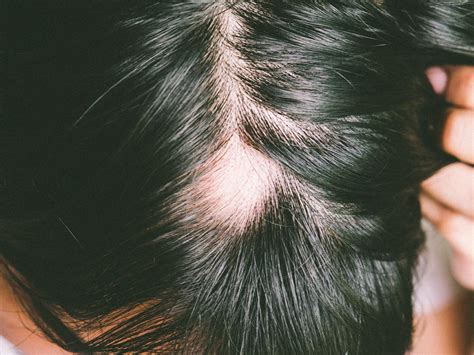Introduction

Hair loss on top of the head, also known as alopecia, is a common concern affecting millions of people worldwide. It can be a distressing experience, impacting self-esteem and confidence. This comprehensive guide delves into the underlying causes, explores various treatment options, and provides strategies for coping with hair loss.
Causes of Hair Loss on Top of Head
1. Androgenetic Alopecia (Male-Pattern Baldness)
Affects: Over 50% of men by age 50
Cause: Genes and hormonal factors
Symptoms: Thinning hair on the crown and temples, receding hairline
2. Alopecia Areata
Affects: About 6.8 million people in the US
Cause: Autoimmune condition
Symptoms: Round or oval patches of hair loss
3. Telogen Effluvium
Affects: 10-30% of postmenopausal women
Cause: Stress, illness, or hormonal changes
Symptoms: Sudden increase in hair shedding
4. Anagen Effluvium
Cause: Chemotherapy or radiation therapy
Symptoms: Rapid hair loss within days or weeks
5. Traction Alopecia
Cause: Tension on hair follicles from tight hairstyles or hair extensions
Symptoms: Thinning hair along the hairline or edges
Treatment Options for Hair Loss on Top of Head
1. Medications
Minoxidil (Rogaine): Over-the-counter topical solution that slows hair loss and promotes regrowth
Finasteride (Propecia): Prescription medication that blocks DHT production and prevents hair loss
2. Hair Transplantation
Procedure: Surgical method to transplant hair follicles from a donor site to the thinning areas
Results: Permanent improvement in hair density
3. Laser Therapy
Technology: Uses low-level lasers to stimulate hair follicles and promote growth
Results: Limited evidence of effectiveness
4. Platelet-Rich Plasma (PRP) Therapy
Procedure: Involves injecting concentrated platelets from the patient’s blood into the scalp
Results: Mixed findings, further research required
Strategies for Coping with Hair Loss
1. Embrace Acceptance
Recognize that hair loss is a common experience and does not define worthiness
Focus on positive self-talk and self-acceptance
2. Style Hair Creatively
Experiment with different hairstyles to minimize hair loss visibility
Utilize hair fibers or thickening sprays to enhance fullness
3. Seek Professional Help
Consult a dermatologist or trichologist for proper diagnosis and treatment advice
Consider therapy if hair loss is causing significant distress
How to Ask a Doctor About Hair Loss on Top of Head
Questions to Consider:
What are the potential causes of my hair loss?
What treatment options are available and what are their expected outcomes?
Are there any lifestyle changes I should make to prevent further hair loss?
Can hair loss be reversed or is it permanent?
Conclusion
Hair loss on top of the head can be a challenging experience, but it is important to remember that there are numerous options available to address the condition. By understanding the causes, exploring treatment possibilities, and adopting coping strategies, individuals can regain confidence and manage hair loss effectively. Remember, hair loss does not diminish your value or worthiness, and there are always solutions to help you feel your best.
Additional Information
Tables:
| Hair Loss Type | Causes | Symptoms | Prevalence |
|---|---|---|---|
| Androgenetic Alopecia | Genes, hormones | Thinning crown and temples, receding hairline | >50% of men |
| Alopecia Areata | Autoimmune | Round or oval patches of hair loss | 6.8 million in US |
| Telogen Effluvium | Stress, illness, hormonal changes | Sudden increase in hair shedding | 10-30% of postmenopausal women |
| Traction Alopecia | Tight hairstyles, hair extensions | Thinning hair along hairline or edges | Common in people with certain hair textures |
Keywords:
- Alopecia
- Hair loss
- Male-pattern baldness
- Treatment options
- Coping strategies
